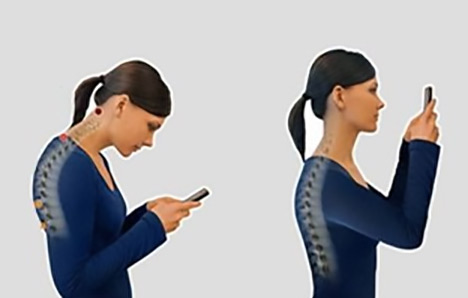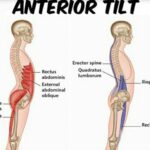In an age where technology has become more and more part of human daily activities, we begin to see how it affects our bodies as well. As can be seen walking downtown on a regular occurrence, many people are looking down at their phones. However, doing this too much can lead to something called Text Neck Syndrome. Text Neck Syndrome is caused by overuse and stress from repetitively bending your neck downward at a cellular device for extended periods of time, likely from texting. This will cause a muscular imbalance where we see the muscles in the back of the neck elongated and stretched but the muscles in the front of the neck to become shortened. Not only do we see people hunching over at their smartphones or tablets, but we also see the same problems with students overly flexing the neck when studying for long periods of time. A study showed that children and adolescents spend an average of 5 and 7 hours a day, respectively, with their heads positioned at a tilt looking at their devices and/or studying. (2)
The Physiology Involved With Text Neck
![[2]](https://images.squarespace-cdn.com/content/v1/568c1797df40f37b331c4d04/1552061204521-ZV8YY6AVTJVMCI6TYMUK/TEXT-NECK.jpg)
When the neck is in the proper upright position, the muscles and spine can easily hold all the weight of the head, which on average is about 10-12 pounds of force. However, when the neck is moved just an inch forward from the proper alignment, that force can be increased significantly and cause the problems we see in Text Neck. This extra force on the spine causes the muscles in the front of the neck to compensate and become overly contracted for long periods of time and shortened while the muscles in the back of the neck to become overly stretched. When these imbalances become present things like pain, stiff neck, headaches, and muscle weakness in the posterior neck and upper back. The cervical spine can also become compressed with this as well which can lead to those symptoms. Over time this can also lead to degenerative discs in the spine as well as changes in its curvature and strength. As this is still a new issue with the growing of technology, more information and studies should come out with an even better understanding of Text Neck.
Treating and Avoiding Text Neck
The most important thing to do to avoid or treat Text Neck would be to use proper posture and awareness. When using a mobile device or reading be aware of the position of your head and flexing for an extended period of time while breaking the habit of overly flexing the neck.
Massage therapy can also be a huge help with this as well. A licensed Massage therapist can target those specific muscles that become shortened and tight to help create a balance. If you think that you have a more severe case of Text Neck, getting a proper diagnosis from your doctor is best. They can then suggest a treatment plan that may include exercises or other treatments along with massage work.
Further reading related to Text neck featuring stretches, strengthening exercises and ergonomics:
- The Levator Scapulae – what a pain in the neck!
- Neck Pain: Where is Your Head Right Now?
- Sleep It On, Don’t Sleep On It (Best Sleep Positions)
- Proper posture at the office desk
References:
- https://www.ncbi.nlm.nih.gov/pmc/articles/PMC5445652/
- https://www.ncbi.nlm.nih.gov/pmc/articles/PMC5445652/#ref19
- https://physioworks.com.au/injuries-conditions-1/text-neck
- https://www.physio-pedia.com/Text_Neck#cite_ref-4
Images:
- http://www.natestretchandmore.com/2017/01/30/way-help-avoid-text-neck/
- https://www.physio-pedia.com/images/6/68/TEXT-NECK.jpg
This article/video is for educational purposes only; do not attempt without your physician’s clearance. If you are in pain or injured, see your physician.
Copyright © Vidal Sports LLC 2019







